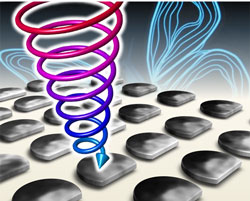The Center for X-Ray Optics is a multi-disciplined research group within Lawrence Berkeley National Laboratory's (LBNL) Materials Sciences Division (MSD). Notice to users.
Exploration of multifunctional systems based on semiconductor and magnetic materials
The LBNL-DGIST Joint Institute for Microscopy (LDJIM) combines DGIST's strengths in hybrid materials synthesis with CXRO's strengths in nanoscale materials characterization to develop and explore hybrid materials offering multiple functionalities in the realm of energy science, electronics, and biology.
Discoveries
LDJIM discovers butterfly effect to trigger stochastic behavior in magnetic vortices
Researchers from the LDJIM have used the unique properties of magnetic soft x-ray microscopy to obtain a deeper fundamental understanding of nanoscale spin behavior, paving the way for potential device applications with unconventional spin textures. With current length scales in devices approaching fundamental limits, however, stochastic, pose severe obstacles. Understanding the root cause of the stochastic (intrinsically random) behavior is key to achieving the ultimate promise of this class of devices and the CXRO XM-1 soft-x-ray microscope ALS Beamline 6.1.2 is ideally suited to this task. XM-1 has recently been used to study large arrays of symmetrically shaped magnetic disks, and it was found that the ultrafast dynamics controlling the vortex formation exhibits a characteristic chaotic behavior known as a butterfly effect, where minute changes can significantly determine the final outcome of a process. A fully deterministic behavior can be obtained by adjusting the disk distances.

Ref: M.-Y.Im, K.-S. Lee, A.Vogel, J.-I. Hong, G. Meier, P. Fischer, Stochastic formation of magnetic vortex structures in asymmetric disks triggered by chaotic dynamics, Nature Communication 5 5620 (2014)
About
The LDJIM was created in 2014 expanding on the partnership between LBNL and DGIST initiated in 2012.
Initial research has concentrated on low-dimensional materials, i.e., 0D nanoparticles, 1D nanowires, or 2D nanoplates or thin films. With proper combinatorial structures made of low-dimensional materials, manipulation of the spins, magnetic domain walls, and even the lattice distortion of the magnetic nanomaterials is possible and can be observed with x-ray microscopy.
Nano-structured materials are prepared at DGIST and x-ray microscopy is carried out at LBNL. CXRO patterning expertise is also leveraged for the post processing of specimens enabling optimized control of the dynamic behavior of spin and domains in the nanopatterns.
Contact Patrick Naulleau if you have questions about the LDJIM.

LDJIM Opening Ceremony. (from left to right): Jung-Il Hong (DGIST), Yong Seung Kwon (DGIST), Steve Kevan (ALS), Peter Fischer (CXRO), Patrick Naulleau (CXRO), and Mi-Young Im (CXRO and DGIST)